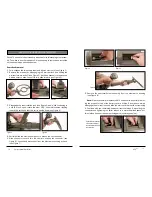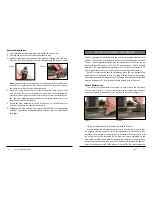
12
Garrett Metal Detectors
ATX
™
13
LEDs 4 and 5 illuminated indicates a
Discrimination setting of 4.5.
As discrimination is increased, you gradually begin to lose targets that
are poor conductors (i�e� saltwater, nickel) and very small, thin targets (i�e�
thin coins, bits of foil, small nuggets, thin jewelry)� Large iron is the last to
be discriminated� It is therefore recommended to search with the default
Discrimination level of zero (1st LED)�
Increase discrimination if desired to eliminate certain small targets, such
as pull tabs or foil, but doing so may also eliminate small desirable tar-
Discrimination
The
ATX
is capable of rejecting or discriminating out certain types/sizes of
targets while still detecting others� The
ATX
has twenty-five (25) levels of
discrimination� The default setting is zero discrimination (1st LED) for maxi-
mum detection of all metals�
To adjust Discrimination:
• Press and release the
SHIFT button to access Secondary controls�
• Use the DISC (+) and (-) buttons to adjust the discrimination to your
preferred level
(see illustration below)
�
• Zero discrimination is indicated by LED 1; maximum discrimination is
indicated by LED 13� Half-step adjustments are indicated by two LEDs
lit simultaneously�
• Press and release
SHIFT button again to exit Secondary adjustments�
Note:
The Red Shift LED must be visible to adjust discrimination�
Non-Motion Mode
can provide additional detection depth and allows
the searchcoil to scan very slowly, even stationary, over targets� Non-Motion
Mode is better at isolating targets, as target signals do not produce the
audio echo which is heard in Motion Mode�
Non-Motion Mode may be less stable and noisier than Motion Mode,
and more frequent Retunes may be required to cancel audio threshold drift
and other environmental changes� Unlike Motion Mode—which automati-
cally works to keep Threshold tuned to a constant level—the more powerful
Non-Motion Mode leaves all Threshold tuning to the user� In highly mineral-
ized ground, Non-Motion Mode may be more susceptible to ground varia-
tions, so it is even more important to use proper coil swing techniques
(see
p. 21)
� The use of Non-Motion Mode requires practice and is not recom-
mended for beginners�
Change detection Mode by
pressing the SHIFT button,
then the NON-MOTION/
MOTION button.
Five stationary
LEDs indicates
Non-Motion Mode.
Change Discrimination
by pressing the SHIFT
button, then the + and -
DISC buttons.
detect targets� When in Motion Mode, the
ATX
constantly adjusts to keep
the Threshold tuned to a constant level (i�e� Auto-Threshold)� In highly min-
eralized ground, Motion Mode can also help to suppress unwanted ground
signals� Target signals produce audio with an echo effect
(see p. 10)
�








































